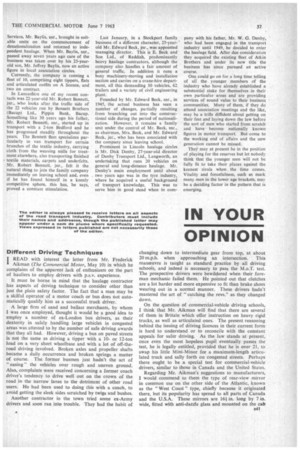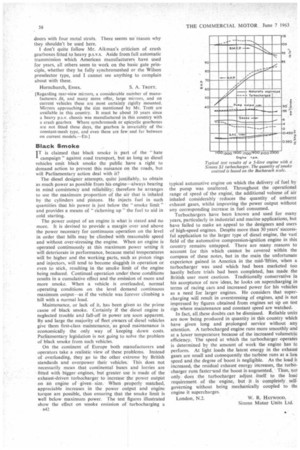IN YOUR OPINION
Page 59

Page 60

If you've noticed an error in this article please click here to report it so we can fix it.
The editor is always pleased to receive letters on all aspects of the road transport industry. Contributors must include their names and addresses, though the published letter may appear under a norn de plume where specifically requested. Views expressed in letters published are not necessarily those of the editor.
Different Driving Techniques I READ with interest the letter from Mr. Frederick Aikman (The Commercial Motor, May 10) in which he complains of the apparent lack of enthusiasm on the part of hauliers to employ drivers with p.s.v. experience.
It must be borne in mind that the haulage contractor has aspects of driving technique to consider other than just the plain safety factor. The fact that a man may be a skilful operator of a motor coach or bus does not automaticallj, qualify him as a successful truck driver.
A large firm of sand and ballast merchants, by whom I was once employed, thought it would be a good idea to employ a number of ex-London bus drivers, as their dexterity in safely handling large vehicles in congested areas was attested to by the number of safe driving awards that they all had. However, driving a bus on paved streets is not the same as driving a tipper with a 10or 12-ton load on a very short wheelbase and with a lot of off-theroad driving involved. Broken axles and propeller shafts became a daily occurrence and broken springs a matter of course. The former busmen just hadn't the art of "easing" the vehicles over rough and uneven ground. Also, complaints were received concerning a former coach driver's tendency to drive well out on the crown of the road in the narrow lanes to the detriment of other road users. He had been used to doing this with a coach, to avoid getting the sleek sides scratched by twigs and bushes.
Another contractor in the town tried some ex-Army drivers and soon ran into trouble. They had the habit of
changing down to intermediate gear from top, at about
20 m.p.h. when approaching an intersection. This manceuvre is taught as standard practice by all driving schools, and indeed is necessary to pass the M.o.T. test. The prospective drivers were bewildered when their foreman mechanic failed them. He pointed out that clutches are a lot harder and more expensive to fit than brake shoes wearing out in a normal manner. These drivers hadn't mastered the art of "catching the revs." as they changed down.
On the question of commercial-vehicle driving schools, I think that Mr. Aikman will find that there are several of them in Britain which offer instruction on heavy rigid trucks, as well as articulated ones. The present reasoning behind the issuing of driving licences in their current form is hard to understand or to reconcile with the constant appeals for safer driving. As the law stands at present, once even the most hopeless pupil eventually passes the test, he is legally entitled, provided that he is over 21, to swap his little Mini-Minor for a maximum-length articulated truck and sally forth on congested streets. Perhaps there ought to be a special test for commercial-vehicle drivers, similar to those in Canada and the United States.
Regarding Mr. Aikman's suggestions to manufacturers, I would commend to them the type of rear-view mirror in common use on the other side of the Atlantic, known as the "West Coast" type, chiefly because it originated there, but its popularity has spread to all parts of Canada and the U.S.A. These mirrors are 16A in. long by 7 in. wide, fitted with anti-dazzle glass and mounted on the cab
doors with four metal struts. There seems no reason why they shouldn't be used here.
I don't quite follow Mr. Aikman's criticism of crash gearboxes fitted to heavy p.s.v.s. Aside from full automatic transmission which American manufacturers have used for years, all others seem to work on the basic gate principle, whether they be fully synchromeshed or the Wilson preselector type, and I cannot see anything to complain about with these.
Hornchurch, Essex. S. A. TRorr.
[Regarding rear-view mirrors, a considerable number of manufacturers .fit, and many more offer, large mirrors, and on current vehicles these are most certainly rigidly mounted. Mirrors approaching the size mentioned by Mr. Trott are available in this country. It must be about 10 years since a heavy p.s.v. chassis was manufactured in this country with a crash gearbox Where synchromesh or epicyclic gearboxes are not fitted these days, the gearbox is invariably of the constant-mesh type, and even these are few and far between on current models.—En.)
Black Smoke IT is claimed that black smoke is part of the hate I campaign " against road transport, but as long as diesel vehicles emit black smoke the public have a right to demand action to prevent this nuisance on the roads, but will Parliamentary action deal with it?
The diesel designer attempts, quite justifiably, to obtain as much power as possible from his engine—always bearing in mind consistency and reliability; therefore he arranges to use the maximum proportion of the air that is inhaled by the cylinders and pistons. He injects fuel in such quantities that his power is just below the " smoke limit" and provides a means of " richening up" the fuel to aid in cold starting.
The power output of an engine is what is stated and no more. It is devised to provide a margin over and above the power necessary for continuous operation on the level in order that hills may be climbed with reasonable speed and without over-stressing the engine. When an engine is operated continuously at this maximum power setting it will deteriorate in performance, because metal temperatures will be higher and the working parts, such as piston rings and injectors, will tend to become sluggish in operation or even to stick, resulting in the smoke limit of the engine being reduced. Continual operation under these conditions results in a cumulative effect and the emission of more and more smoke. When a vehicle is overloaded, normal operating conditions on the level demand continuous maximum output—as if the vehicle was forever climbing a hill with a normal load.
Maintenance, or lack of it, has been given as the prime cause of black smoke. Certainly if the diesel engine is neglected trouble and fall-off in power are soon apparent. By and large the majority of fleet owners of diesel vehicles give them first-class maintenance, as good maintenance is economically the only way of keeping down costs. Parliamentary legislation is not going to solve the problem of black smoke from such vehicles.
On the continent of Europe both manufacturers and operators take a realistic view of these problems. Instead of overloading, they go to the other extreme by British standards and overpower their vehicles. This does not necessarily mean that continental buses and lorries are fitted with bigger engines, but greater use is made of the exhaust-driven turbocharger to increase the power output on an engine of given size. When properly matched, appreciable increases in the power output and engine torque are possible, thus ensuring that the smoke limit is well below maximum power. The test figures illustrated show the effect on smoke emission of turbocharging a
typical automotive engine on which the delivery of fuel by the pump was unaltered. Throughout the operational range ot speed of the engine, the additional volume of air inhaled considerably reduces the quantity of unbumt exhaust gases, whilst improving the power output without any corresponding increase in fuel consumed.
Turbochargers have been known and used for many years, particularly in industrial and marine applications, but have failed to make an appeal to the designers and users of high-speed engines. Despite more than 30 years' successful application to the larger type of diesel engine, the vast field of the automotive compression-ignition engine in this country remains untapped. There are many reasons to account for this which cannot be covered within the compass of these notes, but in the main the unfortunate experience gained in America in the mid-'fifties, when a turbocharger was used which had been marketed too hastily before trials had been completed, has made the British user most cautious. Traditionally conservative in his acceptance of new ideas, he looks on supercharging in terms of racing cars and increased power for his vehicles as a need for larger engines. He considers that supercharging will result in overstressing of engines, and is not impressed by figures obtained from engines set up on test rigs where maintenance and constant speed are watched.
In fact, alLthese doubts can be dismissed. Reliable units are now being produced in quantity in this country which have given long and prolonged service without any attention. A turbocharged engine runs more smoothly and at a lower temperature because of the increased volumetric efficiency. The speed at which the turbocharger operates is determined by the amount of work the engine has to perform. At light loads the latent energy in the exhaust gases are small and consequently the turbine runs at a low speed and the degree of boost is negligible. As the load it increased, the residual exhaust energy increases, the turbocharger runs faster-and the boost is augmented. Thus, nol only does the turbocharger adjust itself to the Toad requirement of the engine, but it is completely self governing without being mechanically coupled to tilt engine it supercharges.
London, N.2. W. R. HAYWOOD,
Simms Motor Units Ltd.




































































































